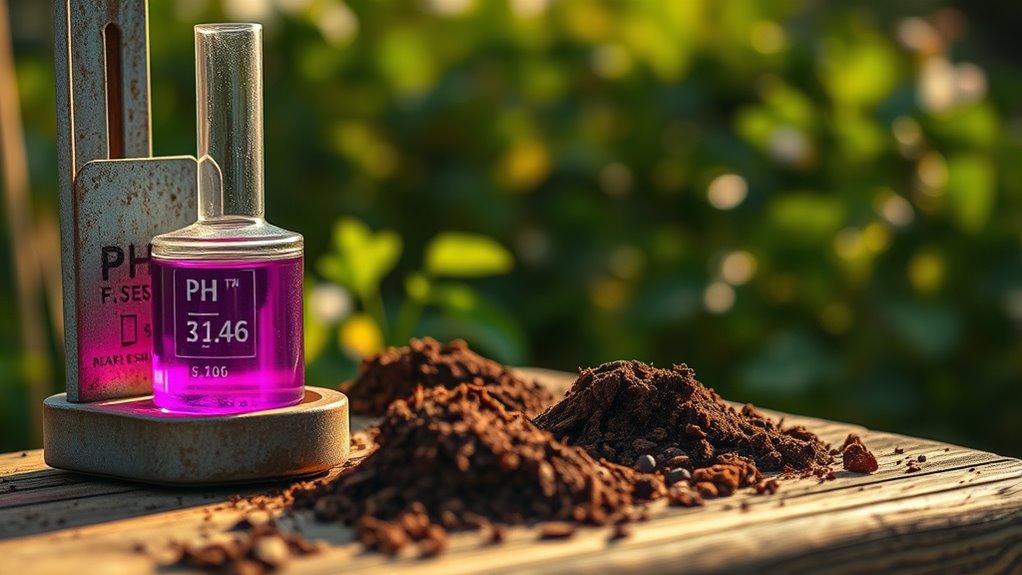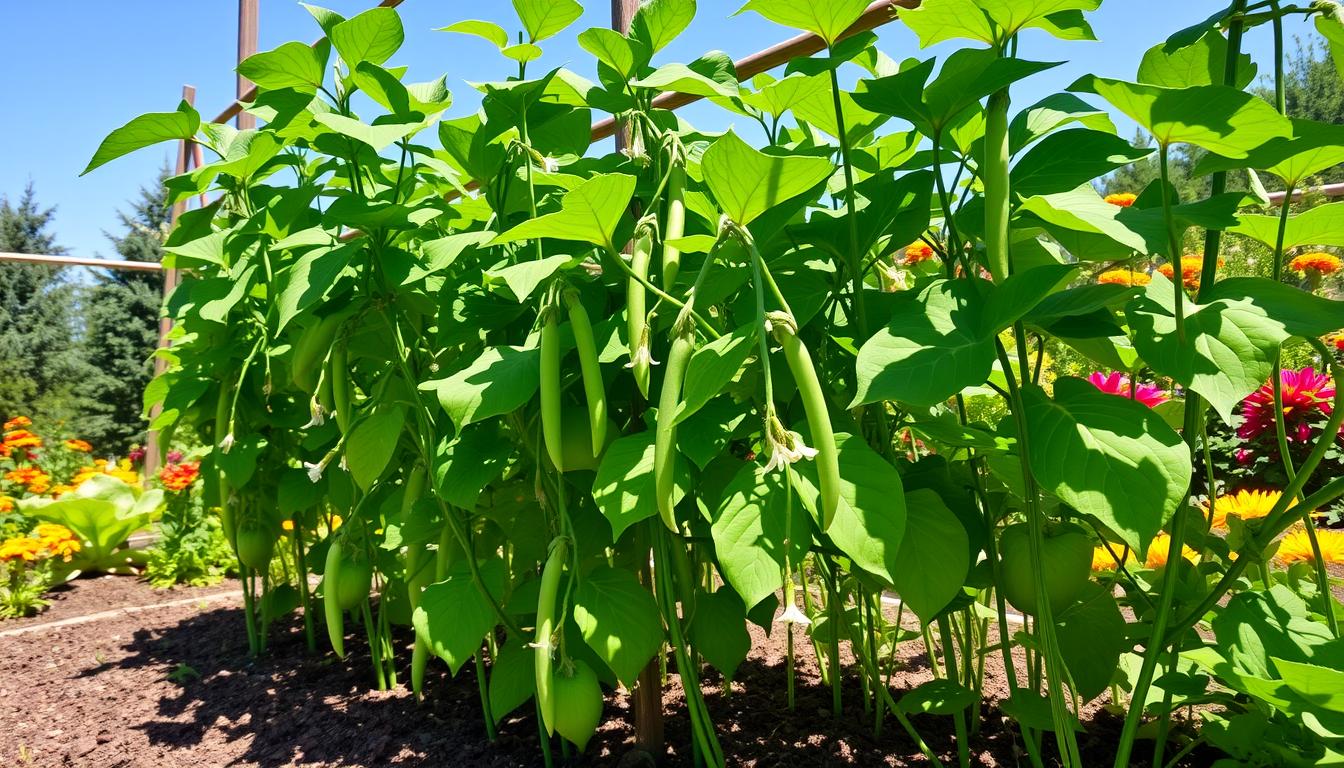After harvesting, you should test your soil’s pH to determine its nutrient balance and health. Wait until the soil cools in late fall or early winter, then collect samples from different areas for accuracy. Use reliable methods like soil test kits, a pH meter, or lab analysis. Understanding your results helps you make necessary adjustments, ensuring ideal conditions for next season’s plants. Keep exploring for detailed guidance on proper testing techniques and adjustments you can make.
Key Takeaways
- Test soil pH in late fall or early winter after crop harvest for accurate assessment.
- Collect multiple samples from different garden areas to ensure representative results.
- Use soil testing kits, pH meters, or send samples to a lab for precise pH measurement.
- Interpret results to identify if soil pH is within the optimal 6.0–7.0 range for your plants.
- Use findings to plan appropriate amendments like lime or sulfur for pH adjustments before planting next season.
Understanding the Importance of Soil Ph in Plant Growth
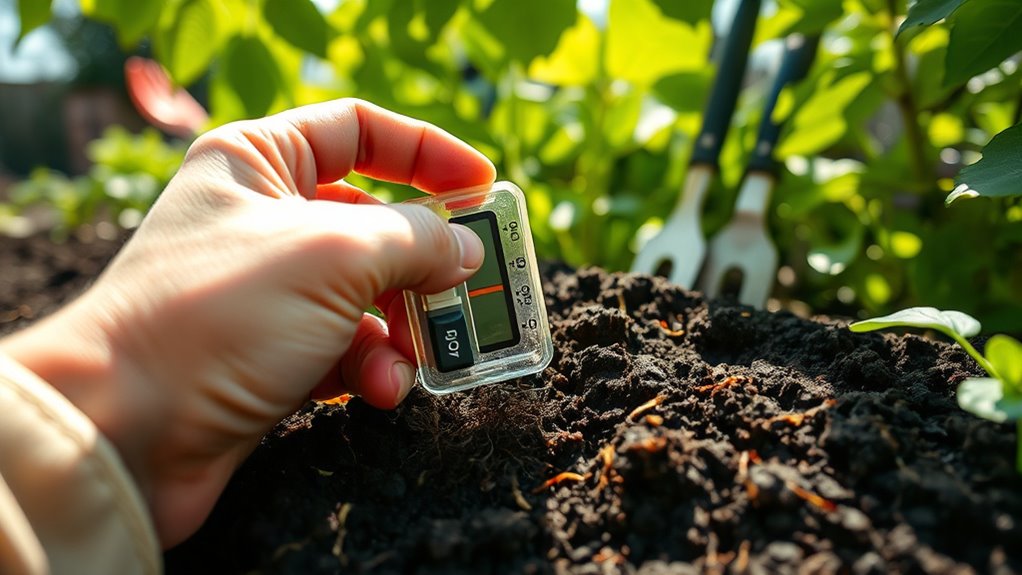
Understanding the importance of soil pH in plant growth is essential because it directly affects how well plants can absorb nutrients. When soil pH is balanced, your plants can access crucial soil nutrients more effectively, leading to healthier growth. If the pH is too acidic or alkaline, nutrient availability decreases, causing deficiencies that impact plant health. This imbalance can stunt growth, reduce flowering, or even kill your plants. By maintaining proper soil pH, you ensure that nutrients like nitrogen, phosphorus, and potassium are available when plants need them most. Monitoring soil pH helps you troubleshoot problems early and adjust your soil management practices. Additionally, using vetted soil amendments can help correct pH imbalances effectively. Regular testing of soil pH levels provides valuable data to guide your soil management decisions and maintain optimal conditions. Understanding soil pH also involves recognizing its influence on the soil’s microbial activity, which plays a crucial role in nutrient cycling and overall soil health. A balanced soil pH can also enhance the effectiveness of soil amendments and reduce the need for excessive chemical inputs. Maintaining optimal soil pH is fundamental because it supports the soil ecosystem, promoting a healthy environment for beneficial organisms. Ultimately, understanding and controlling soil pH is key to promoting strong, resilient plants and maximizing your garden’s productivity.
When to Test Soil Ph After Harvest
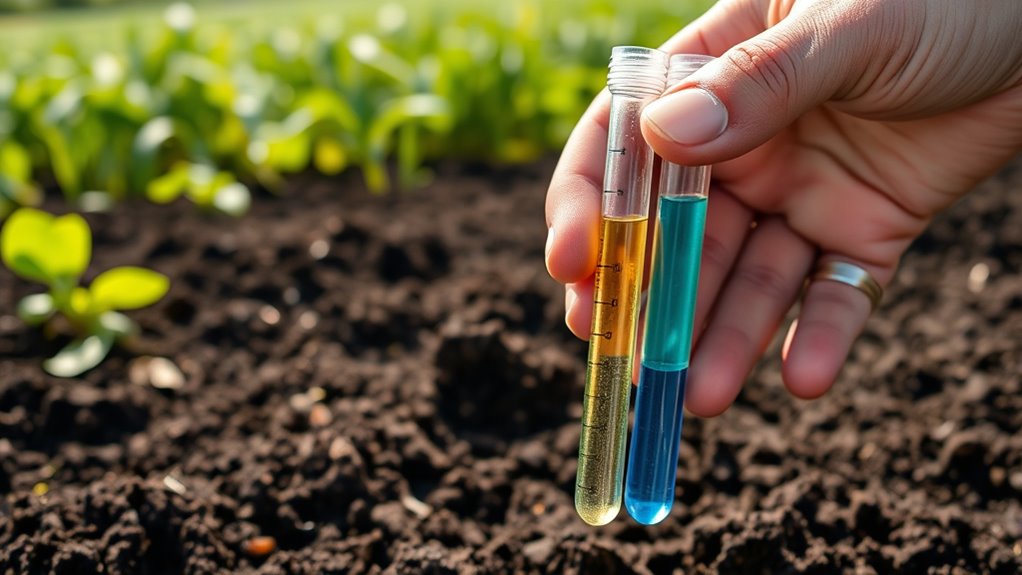
Testing your soil pH after the harvest season is crucial for maintaining healthy soil and preparing for future planting. The key is understanding the best pH testing timing; testing too early or too late can lead to inaccurate results. Ideally, you should collect soil samples after the plants have been harvested and the soil has cooled down, usually in late fall or early winter. This allows the soil to settle and provides a clear picture of its current pH. When collecting your soil sample, be sure to gather multiple samples from different areas of your garden to get an accurate, representative reading. Proper soil sample collection ensures your pH testing results are reliable, helping you make informed decisions about soil amendments for the next planting season. Utilizing soil testing apps can also assist in tracking changes over time and planning adjustments accordingly.
Methods for Testing Soil Ph Accurately

Accurate soil pH measurements depend on selecting the right testing methods. First, you can use soil testing kits, which are easy and quick for on-the-spot results. Second, sending samples for lab analysis provides precise and reliable data, especially for detailed assessments. Third, consider using a pH meter, which offers accurate readings when properly calibrated. When choosing methods, confirm your soil testing kits are fresh and follow instructions carefully. Lab analysis is ideal for exhaustive tests, though it takes more time. A pH meter requires proper maintenance but yields consistent results. Additionally, understanding the importance of HEPA filtration and other technologies can help you interpret your soil test results more effectively. For example, calibration of your testing equipment ensures accuracy, which is crucial for making informed decisions. Proper sampling techniques, such as collecting samples from multiple locations and depths, can also improve the accuracy of your soil pH readings. Combining these methods can give you a well-rounded understanding of your soil’s pH, helping you make informed decisions for your soil management plans.
Interpreting Soil Ph Results and Their Implications
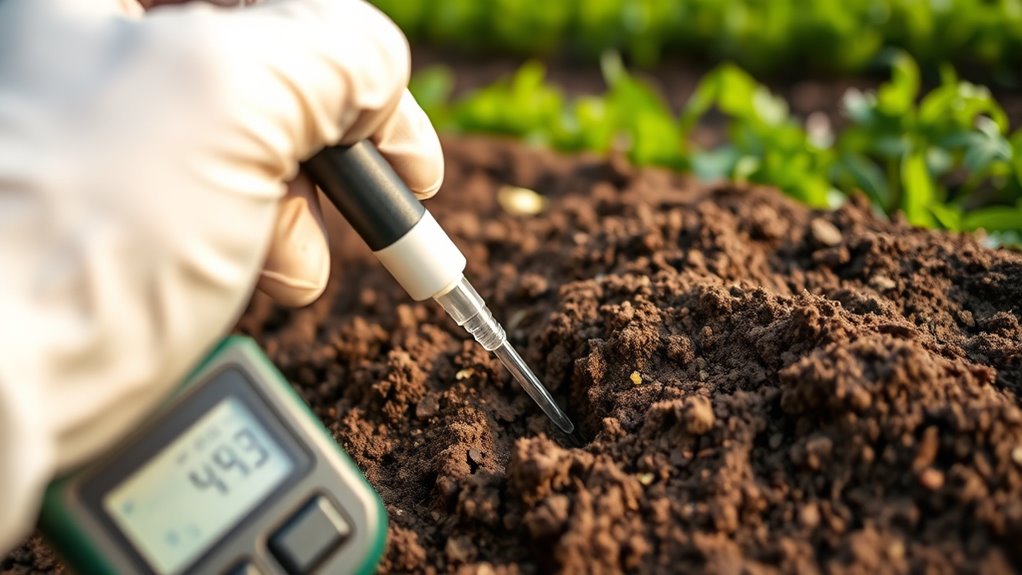
Understanding your soil pH results helps you determine if your soil is within the ideal range for your crops. If the pH is too low or high, you can adjust the soil acidity to improve plant health. Proper interpretation ensures you make informed decisions for future soil management efforts. Additionally, considering potential pitfalls in adopting new soil testing technologies can help you avoid common issues and select the most reliable methods for accurate results. Being aware of accuracy and calibration issues of testing kits is crucial to obtaining trustworthy data and making appropriate adjustments. Regularly monitoring soil conditions and understanding the limitations of testing methods can further enhance your ability to maintain optimal soil health for your plants.
Optimal Ph Range
Have you ever wondered what soil pH levels are ideal for healthy plant growth? The ideal pH range varies by plant, but generally falls between 6.0 and 7.0 for most vegetables and flowers. To maintain this, understanding soil buffering helps you resist pH shifts, promoting pH stability over time. Here’s what you should know:
- Most plants thrive in a pH close to neutral, around 6.0 to 7.0.
- Slight deviations can still support growth, but extreme shifts may hinder nutrient uptake.
- Regular testing and monitoring help keep soil within its suitable pH range for healthy roots and vibrant plants.
- Proper retirement planning can include strategies to manage soil amendments and pH adjustments effectively over time.
Adjusting Soil Acidity
Interpreting your soil pH results is the first step toward adjusting its acidity or alkalinity to suit your plants’ needs. If your soil is too acidic, you can raise the pH by adding soil amendments like lime or wood ash. Conversely, if your soil is too alkaline, sulfur or ammonium-based amendments can help lower the pH. Keep in mind that soil’s pH buffering capacity influences how quickly amendments work; highly buffered soils require more material or repeated applications. Understanding soil buffering capacity can help you plan more effective amendments and avoid overcorrecting. Knowing your soil’s initial pH level is essential for determining the appropriate amount of amendments to apply. Additionally, understanding the rate of soil pH change can help you anticipate how quickly your soil will respond to amendments and plan for future adjustments. Regular testing after amendments is crucial to ensure your soil reaches and maintains the desired pH, especially since soil pH stability can vary over time due to environmental factors. Always test your soil after amendments to assess changes and avoid overcorrecting. Proper interpretation and targeted amendments are key to maintaining a balanced, productive soil environment. Developing a growth mindset can help you approach soil management with patience and resilience, especially when adjustments take time to show results.
Adjusting Soil Ph: Tips for Corrective Measures
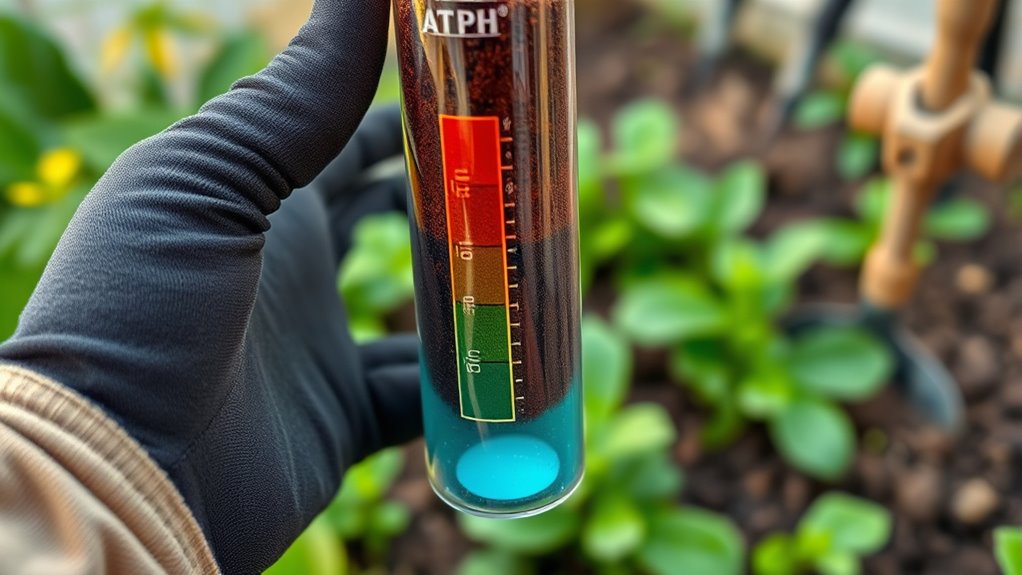
If your soil is out of balance, you need to identify the specific issues before making adjustments. Using appropriate methods like lime or sulfur can help rectify pH levels effectively. Knowing which techniques work best for your soil type ensures healthier plants and better yields. Incorporating soil testing can provide precise pH measurements to guide your corrective measures. Additionally, understanding the types of soil amendments suitable for your soil can enhance the effectiveness of your adjustments. Applying amendments based on field recording techniques can also improve the accuracy of your soil analysis and subsequent improvements.
Identifying Soil Imbalances
How can you tell if your soil is out of balance? One sign is poor plant growth despite proper watering and fertilizing. You might also notice uneven flowering or crop yields. To identify soil imbalances, consider these indicators:
- Unusual plant symptoms — yellowing leaves or stunted growth signal nutrient issues linked to soil pH shifts.
- Altered soil nutrient interactions — when pH is off, certain nutrients become less available, affecting plant health.
- Low microbial activity — imbalanced pH can hinder beneficial microbes, disrupting nutrient cycling and soil vitality.
Regular testing helps confirm these signs. Understanding how soil nutrient interactions and microbial activity relate to pH helps you recognize when your soil needs adjustment. This awareness is key to maintaining a healthy, productive garden.
Effective Ph Adjustment Methods
When your soil’s pH is off, adjusting it promptly can restore nutrient availability and promote healthier plant growth. To do this effectively, consider pH buffering agents like lime for raising pH or sulfur for lowering it. These soil amendments help neutralize acidity or alkalinity, providing a more stable environment for roots. Apply amendments gradually, testing soil pH frequently to avoid overcorrection. Incorporate amendments thoroughly into the soil to guarantee even distribution. For acidic soils, lime can be added in multiple small doses, while sulfur is suitable for alkaline soils. Remember, patience is key—adjustments take time to reflect in soil pH. Proper use of soil amendments combined with pH buffering techniques ensures your soil reaches the most favorable pH for plant health.
Tools and Products for Soil Ph Modification
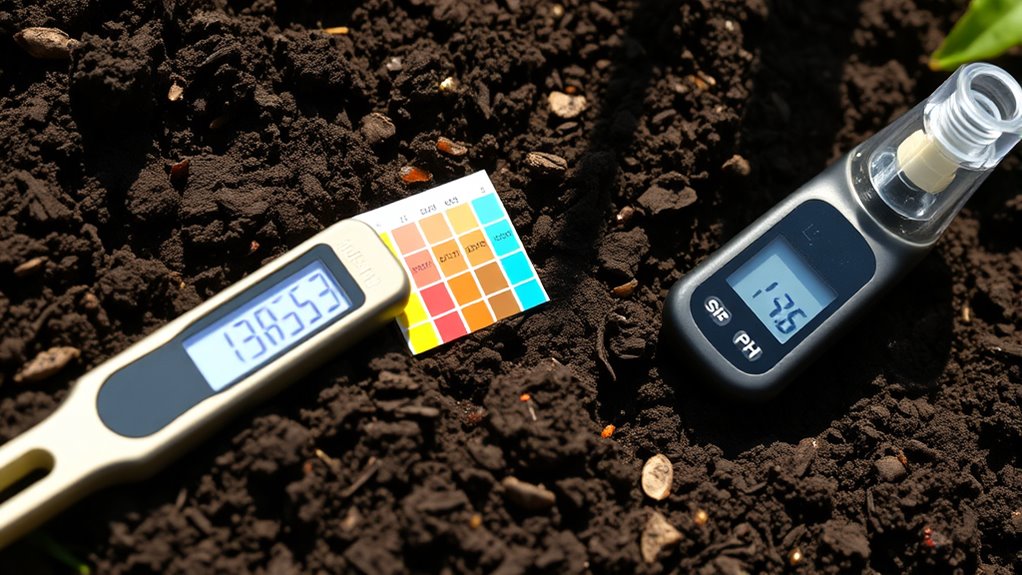
To effectively modify soil pH, you need the right tools and products tailored to your specific needs. Using pH buffering agents helps stabilize soil acidity or alkalinity, making adjustments more efficient. Soil amendments like lime or sulfur are essential for raising or lowering pH levels. Here are three key tools and products:
- Soil test kits – for accurate pH measurement before and after treatment.
- Lime or calcium carbonate – to raise soil pH through pH buffering.
- Elemental sulfur – to lower pH by acidifying the soil.
These products help you target specific pH adjustments quickly and effectively. Proper application, combined with the right tools, ensures your soil remains within ideal pH ranges, promoting healthy plant growth and nutrient uptake.
Planning for Future Soil Management Based on Ph Findings

Accurate soil pH measurements from your recent tests provide the foundation for effective future management. Understanding your soil’s pH helps you optimize the soil nutrient balance, ensuring essential nutrients are available for crops. It also highlights the organic matter influence on pH levels, guiding organic amendments to adjust acidity or alkalinity naturally. To plan effectively, consider this table:
| pH Range | Adjustments Needed | Organic Matter Influence |
|---|---|---|
| 6.0–6.5 | Minor adjustments | Slight increase in organic matter can boost pH |
| 5.5–6.0 | Add lime or organic amendments | Organic matter can lower pH if overused |
| 6.5–7.0 | Maintain current practices | Organic matter stabilizes pH |
| Below 5.5 | Apply lime; improve organic matter | Organic matter can buffer acidity |
Use these insights to tailor future soil treatments for sustainable growth.
Frequently Asked Questions
How Often Should Soil Ph Be Tested Throughout the Year?
You should test your soil’s pH at least twice a year, ideally in early spring and late fall, to stay on top of soil testing. Regular testing helps you determine if your soil needs pH adjustment, ensuring peak conditions for your plants. Frequent monitoring allows you to make timely pH adjustments, preventing nutrient deficiencies or toxicities that can impact your garden’s health and productivity.
Can Soil Ph Affect Nutrient Availability Differently Across Plant Types?
Did you know that soil pH can drastically change nutrient availability, impacting over 90% of plant growth? You should consider how soil buffering capacity affects this, as different plants have unique nutrient needs. For example, blueberries thrive in acidic soil, while vegetables often prefer neutral to slightly alkaline conditions. Understanding these variations helps you optimize soil pH for each plant type, ensuring healthy growth and better yields.
What Are Common Mistakes to Avoid During Soil Ph Testing?
When conducting soil pH testing, avoid common mistakes like sampling errors and pH testing errors. Always collect samples from multiple spots to get a representative reading, and avoid testing on wet soil, which skews results. Use a clean, calibrated pH meter or test kit, and follow the instructions carefully. These steps guarantee accurate readings, helping you make informed decisions about soil amendments and plant health.
How Does Soil Ph Influence Microbial Activity in the Soil?
You should know that soil pH substantially impacts microbial activity by influencing microbial diversity. When pH fluctuates, certain microbes thrive while others decline, affecting nutrient cycling. Ideal pH levels promote a healthy microbial community, enhancing soil fertility. Avoid large pH swings, as they can disrupt microbial balance, reduce diversity, and hinder plant growth. Maintaining stable soil pH helps support beneficial microbes essential for robust soil health and productive growth.
Are There Organic Methods to Naturally Adjust Soil Ph?
You can naturally balance your soil’s pH using organic amendments like compost, manure, or wood ash. These materials release nutrients gradually, helping to raise or lower pH gently. Adding sulfur or peat moss can help lower pH, while lime or crushed eggshells can raise it. Consistently applying these organic amendments supports sustainable pH balancing, nurturing healthy soil, and fostering vibrant plant growth—all through simple, eco-friendly methods that work with nature.
Conclusion
Think of soil pH like the foundation of a house—if it’s off, everything built on it suffers. After your growing season, testing your soil’s pH is like checking that foundation’s stability. I once saw a gardener transform her soil from acidic to balanced, and her tomatoes thrived. Regular testing ensures you catch issues early, much like maintaining a sturdy house. Keep monitoring and adjusting, so your garden’s growth remains strong and fruitful season after season.

